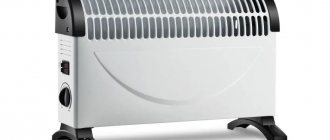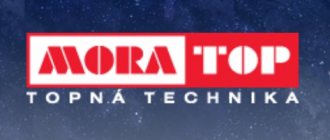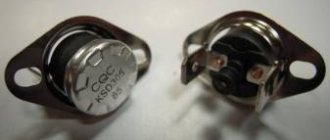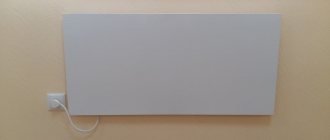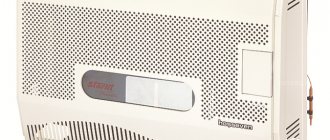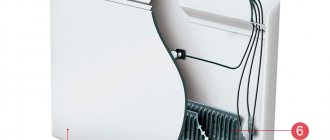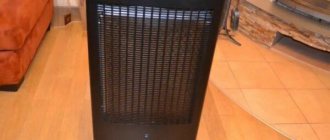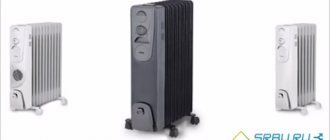When considering options for electric heating of a house, apartment or cottage, you have probably come across such a variety of household appliances as quartz heaters and tried to find reviews from real users about them. The picture that emerges is as follows: people write on forums about their personal experience in using these electric heaters, but negative and positive responses are divided approximately 50/50. Taking into account the interest of homeowners, fueled by advertising campaigns of manufacturers, we propose to find out the real pros and cons of such heaters.
Heating element for a convector - what is it?
By heating element we mean a small-sized device that is built into the lower part of the radiator housing. The operating principle of the device is based on the conversion of electrical energy into thermal energy. Since the consumable resource is relatively expensive, such convectors are often used as additional air heating.
All heating elements are conventionally divided into 2 groups. The open type device is characterized by a degree of electrical protection marked IP21. Control is carried out via a mechanical thermostat. The closed-type device is equipped with an electronic thermostat programmed for specific or customizable temperature values. Convectors with such equipment are characterized by economical energy consumption and protection at the IP24 level.
Where to install the convector?
It is recommended to install electric convectors permanently, under a window (like central heating batteries), thus creating a thermal curtain. It is desirable that the convector completely covers the window opening. The convector is hung on the wall at a height of 8-12 cm from the floor. There should be 12-15 cm from the top edge of the convector to the window sill. In bathrooms, showers, etc. the convector must be located so that the controls are inaccessible to the person taking a shower or bath. The socket into which the convector is connected must not be placed above the heating device.
If it is not possible to install the convector under a window, you can hang it in any other place. Convectors intended for mobile installation are equipped with legs or roller wheels, and also, without fail, with a tip-over sensor
Please note: some convector models cannot be installed on legs or rollers!
Diagnostics of heating elements for electric convectors
In general, a convection heater is a fairly simple device with a small number of components built inside. The basis of the device is one or more heating elements capable of generating heat. If they malfunction, the convector stops heating the room. You can make sure that it is the heater that has failed only by testing it.
As a rule, modern convectors are equipped with closed-type heaters. Their open structures are extremely rare. In the event of a breakdown, a closed heating element is replaced - it cannot be repaired. It is best to check its performance using the simplest multimeter (tester) turned on in resistance measurement mode.
The resistance of the heating element is measured as follows:
- disconnect the power cable;
- set the resistance measurement limit on the multimeter to 200 Ohms;
- apply the tester probes to the contacts of the heating element;
- Based on the readings that appear on the multimeter display, a conclusion is drawn about the serviceability of the heating element.
The heating element is operational if the measured resistance value does not exceed several tens of ohms. In cases where the display shows “0” (short circuit) or the “infinity” icon (break), we can conclude that the heating element is faulty and must be replaced.
So, when choosing a convector, you should first of all find out the type of heating element used. This determines in which room it can be used for its intended purpose. And during operation, you must follow the rules and recommendations indicated by the manufacturer of the equipment in the user manual. This is necessary so that the electric heater lasts as long as possible, since it cannot be repaired.
Which convector to choose, what to pay attention to
Determining whether a monolithic heater, a stitch or a heating element - which is better to choose - allows you to be aware of the device, energy consumption and heat transfer of electrical elements, and maintenance. In the instructions for use of a particular product, the manufacturer always indicates the power of the equipment, the degree of moisture protection, and the equipment with certain devices: regulators, sensors, timers, switches. As an option, the device can be equipped with an ionizer, humidifier, tip-over protection, child lock and remote control.
The radiator power is calculated based on the application relative to the main or secondary heat source. So, for constant use of a convector in a small bedroom, 0.5 kW/h is enough, for a living room of 20 square meters. meters, 1.5 kW/h is enough, and for two rooms you will need at least 3 kW/h. For additional heating, calculations are divided by approximately 1.7-2.
Infrared KOs
The structural basis of infrared KO is:
- tubes with a diameter of 8-10 mm, made of quartz glass (quartz tubes);
- a filament made of tungsten or carbon. It is a heat-emitting element, also called an IR emitter.
Electric wall heaters: types and purpose
Depending on the material of manufacture and the composition of the environment in which the IR emitter is placed, infrared KOs are divided into the following types:
- quartz heaters, which combine under this name a class of devices with a tungsten spiral as a filament. To avoid oxidation of tungsten, the spiral is placed in a vacuum environment, since when heated by electric current, the emitter heats up to temperatures above 2000º C;
- halogen heaters, in which a tungsten IR emitter is placed in a quartz tube filled with inert gases (halogens). In halogen CBs, the filament heats up even more - up to 2800º C;
Halogen appliances produce an overly bright glow, so they are not recommended for heating a bedroom at night.
- carbon heaters equipped with an IR emitter made of carbon filament. The air has been evacuated from the quartz tubes, which has significantly extended the service life.
Based on the placement method, infrared KO models are divided into three types:
- Floor structures that seduce users with their mobility;
Model range of carbon infrared floor-mounted heaters
- Wall-mounted models that save space in small spaces;
- Ceiling structures of various capacities, capable of heating large areas.
Tubular heaters (TEH) with aluminum fins
A tubular electric heater (TEH) is a nichrome filament installed in a steel tube filled with quartz, ceramic or magnesium. An aluminum fin is attached to the tube, which acts as an effective heat exchanger. As a rule, the configuration and arrangement of aluminum finning plates differs from one manufacturer to another, but this does not change the meaning. The developed fins of such an aluminum diffuser ensure intense heat transfer from the heater to the air and enhance convection. The temperature of such heaters is significantly lower than needle heaters, they are also more unpretentious and more durable. Basically, convectors with tubular heaters are made in a splash-proof design (IP24) and are approved for installation in wet rooms at a distance of at least 60 cm from “open water” (bathtubs, pool edges, etc.).
Devices with such heaters are more expensive than needle convectors, but cheaper than monolithic ones. For example, heating elements are installed in Atlantic convectors
or
Thermor
.
Kinds
There are two types - infrared and quartz. The first are the simplest heating devices with a luminous glass tube that emits heat (sometimes there are two or even three tubes). They are divided into wall and floor, horizontal and vertical. The devices are intended for indoor use and cannot be used outdoors.
Quartz monolithic heaters heat by convection - they heat the air that circulates throughout the room, slowly warming up the entire volume. These devices are manufactured in the form of modules ready for installation and operation, so their installation and further use do not cause any special problems. The equipment can be called extremely unpretentious and extremely economical.
A quartz heater is a practical modern device for arranging alternative heating, which contains elements of quartz sand. It can serve as both main and auxiliary heating equipment.
To function correctly, it is connected to the electrical network and creates comfortable heat by passing current through a high-resistance element. Demonstrates an impressive level of efficiency and does not burn oxygen.
Monolithic heating elements
In monolithic heating elements, a nichrome filament with a dielectric filler is located in a solid aluminum body with developed fins. When heated and cooled, all parts of the monoblock expand and contract equally, which eliminates friction and the appearance of microcracks. They are silent in operation and very durable. The monolithic design made it possible to minimize intermediate heat losses and further reduce the temperature on the surface of the fins compared to heating elements. Typically, devices with such heaters have a degree of protection of IP24.
Convectors with a monolithic heating element: NOBO
Sometimes you look at a convector, it costs about 10 thousand, you expect the latest technologies used by NASA astronauts, you see a super-exquisite design, the kind only to be installed at a reception with the Queen of England at Buckingham Palace, and inside there is a heating element made using technology 50 years ago , the fire hazard of which is quite comparable to playing matches near a gas station.
The trouble is that even old technologies are still used in modern heating devices. How to avoid making the wrong decision and not buying garbage with an obsolete heating element - read here. We've done a quick review of three different heating elements, ranking them from worst to best.
Stitch heating element.
The stitch heating element is a steel wire on a dielectric base, which has a very high external temperature. During operation of the convectors, the air speed is not very high, so it does not have time to take all the heat from this heating element (this is a thin wire) and the slow air flow does not have time to cool it to the required level, and the wire is almost red-hot. It is located inside a steel case, which is not safe either from the point of view of operating temperature or from the point of view of operating durability. Any dust and small debris floating in the air also participate in the convection mode, and when deposited on the hot wire they burn, causing an unpleasant odor, and in case of breakdowns can lead to unpredictable consequences. Dust and dirt burned on the heating element disable it and at this point it simply burns out. This is the most outdated technology, but due to cheaper products, it is often found even in expensive electric convectors.
Steel heating element in an aluminum jacket
An aluminum jacket is put on the steel tube, which allows heat to be removed from the steel tube and participates in the heat exchange process. It is more reliable compared to a stitch heater, less hot, there is no characteristic burning smell, but due to the fact that the temperature coefficient of expansion of steel and aluminum is different, constant thermal deformations of steel and aluminum occur - we hear characteristic clicks and crackles as the heating element heats up , and then during the cooling process.
Monolithic heating elementMonolith is the most advanced and expensive. Made from a monolithic composition of silumin, which is cast in a single mold. The shape of the heating element is X-shaped, which is why they are often called X-shaped heating elements. Due to the fact that the structure is monolithic, unlike a heating element in an aluminum jacket, it does not cause any clicks or crunches during the heating and cooling process. The monolithic structure allows the entire element to be evenly heated to a single temperature and the entire heating element is fully involved in the heat exchange process. The features of its production make it possible to make it larger in area than any other heating element, and the higher the area of the heater, the higher and more efficient the heat removal from the heater and this heating element. As a result, this is the most modern heating element.
Let's summarize: The most reliable and perfect is monolithic. Its operating temperatures are lower than any other
Nothing will flare up from it, there are fire safety tests for devices in which such heating elements are installed (applicable to the brands Ballu, Electrolux, Zanussi). When choosing an electric convector or any other heater, be sure to pay attention to its heating element. Monoliths have been in use for at least 10 years and the technology has already stood the test of time and proven itself in every possible way
They consume less electricity and reach the desired heating temperature faster. If you are looking for a heater with a monolithic heating element, look at the brands Ballu and Electrolux.
About the disadvantages and advantages
Since our task is to determine the real pros and cons of quartz heaters, we will not repeat the advertising statements of manufacturers, but will highlight the negative and positive aspects based on user responses. Let's start with monolithic batteries, whose advantages are as follows:
- affordable price of products (from 40 USD);
- the device does not create noise during operation;
- the most simple design, where the parts are embedded deep into the slab, allows you to reduce the maintenance of the product to cleaning from dust;
- the product is environmentally friendly, as it is made from natural materials;
- heaters, correctly selected in terms of power and quantity, warm up the room quite quickly thanks to two heat transfer paths - infrared radiation and convection.
Different textures and colors of the front panel of the quartz heater
Note. We deliberately do not list high efficiency among the advantages of heating plates, because it is inherent in all types of electric heaters. The fact that the heater does not burn oxygen when heating the air has long ceased to be an advantage, since similar disadvantages have been eliminated in other types of heaters.
Unfortunately, a solid list of advantages of monolithic heating devices is offset by a list of disadvantages:
- Decent weight, like a small cast iron radiator. When placing on the wall, you will need a reliable mount.
- The fragility of the slabs, often cracking and breaking into pieces even at the transportation stage. Also, cracks appear after the first switching on and warming up of the stove.
- The unattractive design and unsightly appearance immediately make it clear that this is a budget product.
- The heater cannot simply be plugged in, otherwise it will constantly and uncontrollably “plow” at full power. You need to buy a thermostat for a separate fee and connect it to an electric battery.
- Too high a surface temperature (95 °C) can cause burns, which is especially dangerous for small children. Again, you need to invest in a protective screen.
If the heater looks good from the front, the rough stand and rear panel spoil the impression
. A separate issue is the quality of manufacture of quartz heaters for a home or apartment, which is clearly visible on the back side of the stove (shown in the photo). According to reviews, users often receive products with peeling paint, cracks, or no sockets included, which does not add to its popularity. But the worst thing is when an electric heater connected to the network produces an electric shock when accidentally touched (there are also such things). This makes it dangerous for all residents and even pets.
For reference. In addition to quartz, purely ceramic heaters with a rear reflective layer, a convective screen and beautiful design have appeared on the market. But their price is 50% or more higher, and they heat no better. That is, due to the increase in price, the design problem was eliminated, but the efficiency did not increase.
Beautiful ceramic heater - picture
Infrared tubular devices also do not make noise during operation (sometimes they crackle slightly), but their design is more advanced than that of heating plates. This is expressed by the following advantages:
- instant heating of surfaces, bypassing the air;
- safety in operation;
- light weight and mobility;
- presence of a built-in thermostat;
- attractive design;
- acceptable sizes;
- wide selection of models and brands.
For reference. Due to the ability to quickly raise the temperature of surfaces, infrared quartz heaters can be installed directly on the street for the purpose of local heating of people.
The choice of infrared quartz heaters is very wide.
At a price, such household appliances will cost more than panel heaters, but they do not have to be completed. A significant drawback of an IR heater is that it warms up the room space too slowly; at first, a person is comfortable only in the range of the device.
Types of Electric Heaters
In the production process of modern electric convectors, manufacturing companies use three types of electric heating elements:
- stitch;
- heating element;
- monolithic.
Each of the mentioned types of heaters has its own unique advantages and disadvantages, therefore, before buying an electric convector, it is advisable for a potential consumer to familiarize himself with them in more detail.
Stitch heaters
Stitch heaters (from English: sew, quilt) are also called needle or tape heaters. This is a flat dielectric plate (tape) stitched with a conductive thread with an insulating varnish coating. A thin chromium-nickel wire forms loops on both sides of the plate, which, under the influence of electric current, instantly heat up to a high temperature and also quickly cool down when it is turned off. In this case, the hot thread comes into contact with the air, which can lead to overdrying.
The main advantage of needle heaters is their low cost. At the same time, convectors manufactured using them have a number of significant disadvantages, among which the following can be noted:
- low thermal inertia;
- low coefficient of efficiency (efficiency);
- insufficient degree of electrical protection (not higher than IP21), and therefore they cannot be used in rooms with high humidity;
- fragility, which is due to the fragility of the heaters themselves;
- high level of fire hazard - dust getting on a hot coil causes sparking, which can lead to a fire;
- increased requirements for transportation.
In the domestic market, tape heaters are most often found in electric convectors made in China (General company, etc.).
Tubular heaters
A traditional tubular electric heater (TEH) is structurally a durable steel flask, inside of which there is a quartz, ceramic or magnesium filler. A nichrome thread is also integrated inside the flask, which is heated by electric current.
In addition, an aluminum diffuser (reflector) with a large number of fins is mounted on top of the flask body, the location, number and configuration of which can vary. The latter significantly increase the contact area of the heating element with cold air and, as a result, the heat transfer of the heating element, as well as air convection. Such heating elements are completely sealed, and the hot coil does not come into contact with the air and therefore does not dry it out. Tubular heaters are durable and unpretentious during operation.
Despite a number of advantages that distinguish heating elements from stitch heaters, they are not without drawbacks. The main ones:
- loose fit of the reflector to the bulb, which leads to heat loss;
- different coefficients of thermal expansion of the steel flask and aluminum fins, which contribute to their mechanical damage (cracking).
The production of electric convectors with tubular heaters is organized in many countries around the world. The most famous products are from Ballu (China), Siemens (Germany), Thermor (France), etc.
Monolithic heaters
Their monolithic counterparts are completely free from the disadvantages inherent in strip and tubular heaters. In such designs, the dielectric filler and nichrome thread are integrated into a solid aluminum body, made integral with the fins.
In this design, all elements have the same coefficient of thermal expansion, which eliminates the appearance of microcracks during cyclic temperature changes. In addition, convectors equipped with monolithic heaters are silent and durable in operation. They are also characterized by a minimal level of heat loss.
A significant disadvantage of monolithic structures and products made on their basis is the relatively high cost. One of the best examples of such an electric convector is considered to be the Electrolux 1000 series device, equipped with a modern monolithic X-shaped heater X-DUOS with a power of 1 kW.
Infrared heating
A feeling of warmth occurs in a person when his body is exposed to electromagnetic radiation by waves from the infrared region of the spectrum. Therefore, infrared radiation (IR radiation) is usually called thermal radiation, and the heat from it is called infrared heat.
Since time immemorial, man has learned to do without solar heat, using a variety of heating devices in his home. Water heating radiators, so familiar to us, create a home microclimate through convective and radiation heat exchange with the environment. Air masses with a higher temperature rush upward and accumulate there, introducing a certain temperature imbalance in the distribution of heat in the living space:
- under the ceiling the air temperature is 22º C;
- the lower part of the room (in which people are located) does not warm up above 18 degrees.
In the case of infrared heating, the thermal radiation of the CO ensures uniform distribution of heat throughout the room. In Fig. Below is a comparative picture of the distribution of the temperature field for convective heating using water heating batteries and the infrared heating method using ceiling-type CO.
Comparison of temperature fields for convective and infrared heating methods
By analogy with sunlight, heating a room with artificial infrared radiation occurs through heat exchange between furnishings and the surrounding air. The air itself is not heated by IR waves; it is transparent to them and allows the waves to pass through unhindered.
Only objects that are exposed to infrared waves heat up. It is their heat that heats the surrounding air. This property of IR radiation is used for local heating of individual areas in the living room using portable heat exchangers.
Types of Electric Heaters
Structurally, heating elements are presented in different designs. Accordingly, depending on which heating element is built in, the operating principle and technical characteristics of the convector have their own distinctive features, advantages, and disadvantages
Before choosing a particular convector radiator, it is important to familiarize yourself with these aspects in advance
Stitch
The name of the heating element translated from English means “sew” or “quilt”. In Russia, the concept of needle heating element is more common. Structurally, the device is represented by a dielectric plate and a continuous conductive filament. It is made of a nickel-chrome alloy and coated with oxygen-insulating heat-resistant varnish. The wire forms many loops on either side of the flat base.
Manufacturers, as a rule, install 2 such heaters. An electric convector with needle heating elements has the following advantages:
- heating to +250 degrees Celsius or more and cooling of the filament occurs within a few seconds;
- operation of the equipment is accompanied by noiselessness;
- energy consumption is economical.
One of the disadvantages is direct contact with oxygen, which helps to lower the humidity in the room. If dust comes into contact with a hot wire, there is a risk of sparking and fire. The thin filament is fragile, so radiators do not last long.
Important! Stitch-type heating elements do not have additional protection from direct contact with water. This fact limits the scope of application to dry rooms only.
Tubular
Tubular-type elements are represented by a flask made of high-strength steel. The filler of the container is fine sand made of quartz, ceramics or magnesium. To prevent the mixture from spilling out, the device is equipped with plugs. Heating of the mineral dielectric occurs through a nichrome thread passed inside.
To increase the range of air covered, flat or spiral elements made of aluminum with a high thermal conductivity coefficient are additionally attached to the flask. Each manufacturer develops fins using its own technology. However, the heat transfer of convectors with a tubular heater of various designs is almost the same.
Compared to a needle heating element, the filament of the tubular element is isolated from dust, moisture and oxygen. This allows you to increase its service life by about 1.5-2 times. The use of a radiator in wet rooms is allowed, since manufacturers often provide a degree of protection marked IP24.
Important! Despite protection from splashes, it is recommended to place convectors at a distance of more than 0.6-1 m from water sources. Heat transfer from a heating element with fins occurs within a few minutes, which is spent transferring energy to the mineral filler (the same can be said about cooling)
The aluminum reflector does not fit tightly to the main working part, so partial heat loss occurs. Because of this, energy consumption increases. During thermal expansion and contraction, metal often makes a crackling sound because the process is uneven
Heat transfer from a heating element with fins occurs within a few minutes, which is spent transferring energy to the mineral filler (the same can be said about cooling). The aluminum reflector does not fit tightly to the main working part, so partial heat loss occurs. Because of this, energy consumption increases. During thermal expansion and contraction, metal often makes a crackling sound, as the process proceeds unevenly.
Monolithic
The heater in a solid design eliminates the disadvantages of the needle and tubular type. The reason for this is the location of the filament inside the solid-cast structure of a silumin bulb with X-shaped fins. Quartz is often used as a filler.
All the advantages of the radiator are determined by the monolithic type of the heater and the uniformity of the metal structure. In particular, there is no sound, nickel-chromium wire is isolated from the environment and lasts a long time, heat loss is minimized, and does not affect the relative humidity of the equipment. The scope of application has practically no restrictions regarding internal premises. The disadvantages include the relatively high cost.
Which convector to choose
If we talk about which heater is better to choose, the answer will be ambiguous. With all the obvious advantages, each type has its own disadvantages. For example, the tubular element has the longest glow time. During active operation, it can make clicking sounds and squeaks caused by the expansion of the structure. In turn, the monolithic element scares off most buyers due to its high cost. Not everyone is willing to overpay for a significant degree of protection and minimal heat loss.
The decision about which convector is more efficient should be made based on the characteristics of the heated room.
If the room is not humid and the speed of air heating does not play a key role, a conventional heating element is best suited.
However, if it is necessary to constantly maintain comfortable conditions in the room, it would be more correct to give preference to a monolithic element
An efficient convection system will allow you to save a little on electricity. You can also turn your attention to combined type models, such as an infrared heater with a convection function. This device combines heating through a heating element and an infrared element, which allows you to quickly warm up the room with little electrical energy consumption.
Experts advise paying attention not only to the heating element. Maximum operating power, spatial arrangement, mobility and ergonomics of the housing also make a significant contribution to efficiency
Carefully study the technical characteristics of the device, and you can easily choose the convector that suits you.
We are expecting the arrival of a large batch of Ballu thermal curtains with two types of heating elements: heating elements and a stick element. What a heating element is is always clear to the buyer, but the stitch element usually raises doubts. And in vain! The stitch element is a modern needle-type heating element made of nichrome (an alloy of nickel and chromium). The stitch element has its advantages compared to the heating element. This is fast heating and low inertia (fast heat transfer). The latter property eliminates the presence of residual heat on the heating element of the thermal curtain in the event of an emergency shutdown. In addition, thanks to the use of a stitch element, the curtain has less weight. And finally, there is a significant difference in price: thermal curtains with a stitch element are cheaper and, therefore, are the best seller.
However, Ballu heating element curtains have long since won a strong position in the market.
Gone are the days when the buyer had to explain for a long time what Ballu is and how long this brand has been on the market. Ballu heating equipment was recognized as a sales leader in Russia based on the results of 2011!
Ballu thermal curtains are produced in several series. Each series has a wide range.
Electric thermal curtains of the S series (stitch element) - from 3 to 9 kW, T series (heating element) - from 3 to 36.5 kW.
Powerful water heat curtains in terms of performance and heating - from 9 to 35 kW. Well, the designer curtains of the Stella series are a separate topic, which we will write about in the next blog.
Heating element thermal curtains have higher air output, longer air flow, and larger dimensions. And they are installed on large doorways. If you need to close garage or warehouse doors, look at heating element curtains
Do not forget that when selecting a thermal curtain, it is important to take into account two parameters - the length and height of the doorway. Air curtains with a power of 9 kW are produced for a voltage of 380 V
Air curtains with a power of 6 kW have two connection options: 220 and 380 V.
Rating of the TOP 10 best quartz heaters for the home for 2021-2022
| TOP 3 best quartz heaters by price/quality | ||
| 1 | Ballu BIH-LM-1.5 | Find out the price |
| 2 | Hintek IW-03 | Find out the price |
| 3 | Ballu BIH-LM-3.0 | Find out the price |
| TOP 3 best quartz heaters with floor installation | ||
| 1 | Ballu BIH-L-3.0 | Find out the price |
| 2 | NeoClima NQH-1.2i | Find out the price |
| 3 | Sakura SA-0670 | Find out the price |
| TOP 2 best quartz heaters for wall mounting | ||
| 1 | Ballu BIH-L-2.0 | Find out the price |
| 2 | NeoClima Shaft 2.5 | Find out the price |
| TOP 2 best monolithic quartz heaters | ||
| 1 | NIKATEN nt 300 | Find out the price |
| 2 | TeplEko from pure quartz sand | Find out the price |
Which type of thermostat should I choose - electronic or mechanical?
Convectors are equipped with two types of thermostats: mechanical and electronic. The name of the thermostat reveals the principle of temperature measurement. In the case of a mechanical thermostat, a capillary air thermostat is used to measure the room temperature. An electronic thermostat uses a microcontroller and a thermal resistance to measure temperature. For the end user, this information is not so necessary; other differences are more important: an electronic thermostat is more accurate than a mechanical one (measurement accuracy is 0.1-0.3 C versus 1-2 C for a mechanical one) and the convector with an electronic thermostat operates silently. A special feature of convectors with a mechanical thermostat is a characteristic “click” when the convector turns the heating on and off. However, convectors with “mechanics” are cheaper and, so to speak, more “oaky”. At the same time, the accuracy of electronic thermostats allows you to save an additional 5-7% of electricity.
The controls for convectors with “mechanics” and “electronics” may not differ. For European manufacturers, this is usually a rotating knob or a moving slider for setting the temperature, as well as an operating mode switch (if there is one).
If you see a convector with an LCD screen, a remote control, power switching, some kind of “ionizers” and other “whistles and tricks” - 99% that this is a Chinese-made product.
